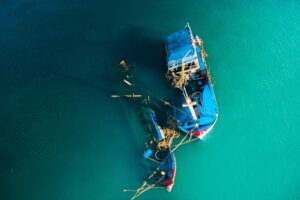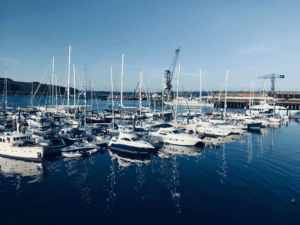 To avoid colliding with another boat, always be aware of your surroundings and follow the rules of the water. It includes maintaining a proper lookout, following safe speeds and maneuvering, and communicating with other boats using visual and audio signals. It is also essential to clearly understand the right-of-way rules to determine who should give way in a potential collision situation.
To avoid colliding with another boat, always be aware of your surroundings and follow the rules of the water. It includes maintaining a proper lookout, following safe speeds and maneuvering, and communicating with other boats using visual and audio signals. It is also essential to clearly understand the right-of-way rules to determine who should give way in a potential collision situation.
Additionally, having proper safety equipment on board, such as life jackets and radios, is essential to keep in your boat that can prepare you for emergencies. By staying alert and following the guidelines, you can significantly reduce the risk of a collision on the water.
The following are ways to avoid having a collision:
Maintain a proper lookout
Maintaining a proper lookout means constantly scanning the surrounding waters for potential hazards and taking appropriate action to avoid a collision. It includes:
- Regularly checking navigation equipment and instruments.
- Using binoculars.
- Assigning designated crew members to specific areas for lookout duty.
By keeping a vigilant eye on the surroundings, boaters can spot approaching vessels, potential obstacles, and changing weather conditions in time to make necessary changes to their course or speed. It dramatically reduces the chance of a collision occurring.
Tips:
1. Communicate with other vessels, using signals or radio to ensure proper understanding of intentions and avoid confusion.
2. Pay attention to navigation rules and traffic patterns in busy areas.
3. Stay alert and attentive, particularly during periods of low visibility or heavy traffic.
4. Constantly reassess the situation and adjust actions as needed.
Maintaining a proper lookout is a crucial aspect of responsible and enjoyable boating. In addition to preventing collisions, keeping the right watch helps boaters stay safe and enjoy their time on the water. They can react quickly and confidently in emergencies by remaining alert and aware of potential hazards.
Follow Safe Speed and Maneuvering Practices
The speed at which a vehicle travels can play a significant role in whether or not a collision occurs. Driving too fast can lead to losing control and make it more difficult to stop or maneuver around hazards. On the other hand, moving at a safe speed allows for better reaction time and increases the likelihood of avoiding collisions.
Maneuvering practices, such as turning signals and checking blind spots, can also prevent collisions. Checking blind spots eliminates the possibility of merging into a lane with another vehicle or object. Signaling turns and changing lanes will communicate intentions to other drivers and helps avoid miscommunication or sudden movements that could lead to accidents.
Always be aware of one’s surroundings and make thoughtful decisions while operating a vehicle to prevent accidents and stay safe on the road. Following safe speed and maneuvering practices helps avoid collisions and promote safe driving. Adhering to these guidelines can protect the driver, passengers, and other individuals on the road.
Some boaters like to go faster and have fun. Usually, a safe speed on water is about 5 knots (5.75 mph). However, that will also increase the chances of a collision with another boat or object.
Likewise, using proper maneuvering techniques can prevent collisions on the water. Checking for other boats in the vicinity before turning or changing course can help avoid accidents and maintain safety while boating.
Understand and comply with the right-of-way rules
Right-of-way rules on water establish a system for determining which vessel is responsible for giving way in any given situation. It helps avoid collisions by providing a clear set of guidelines for all boaters to follow.
However, it’s important to remember that even if one vessel has the right-of-way according to the rules, they still have a duty to take action to avoid a collision. It means being aware of other ships and their movements, constantly monitoring your surroundings, and maneuvering safely.
It’s also important to know that right-of-way rules can be suspended in certain circumstances, such as when restricted visibility or sudden emergencies occur. You should apply common sense and good judgment in these cases to avoid a collision.
By understanding and complying with right-of-way rules, boaters can ensure safe navigation on the water and prevent collisions. Remember always to exercise caution and good judgment while operating your vessel.
Communicate with other boats using visual signals
Communicating with other boats using visual signals, also known as “Rule of the Road Signals,” is an essential aspect of safe boating. These signals not only allow for communication between boats but also help to avoid collision on the water.
Some standard visual signals include flag hoisting, sound, and light signals. Flag hoistings can convey various messages, such as a boat’s intention to maneuver or nationality.
Sound signals, like blasts from a horn or bell ringing, can also indicate a boat’s intent to maneuver or the direction they are traveling in. Light signals, such as flashing lights or lamps, can convey a boat’s intent and position on the water.
Visual signals allow communication between boats that may not be close enough to communicate verbally. It also helps to clarify any confusion surrounding a boat’s intentions, avoiding collisions or misunderstandings on the water.
All boaters need to be familiar with these visual signals and their meanings. We can ensure safe and clear communication on the water by utilizing visual signals.
Things to remember when using visual signals on boats
1. Make sure signals are clear and easily understood
2. Use signals in addition to verbal communication, not as a replacement
3. Always be aware of your surroundings and the signals used by other boats
4. Follow all boating laws and regulations regarding visual signals.
5. Have a plan for emergency visual signals in case of distress.
Who is responsible for avoiding a collision between two boats?
All boat operators have a responsibility to avoid collisions. It includes following navigation rules, maintaining a proper lookout, and acting safely and prudently. However, the “stand-on” vessel (the one with the right of way) has a greater responsibility to avoid a collision.
If both boats fail to follow navigational rules and act prudently, the controlling factor in determining fault will be which ship had the better opportunity to prevent the collision.
Ultimately, it is up to all boat operators to do their part in avoiding collisions. It is important to always exercise caution and good judgment while on the water.
The above points are excellent boat collision prevention. However, one thing you must not forget is having good quality windows in your vessel. High-quality windows, made with tempered or laminated glass materials, provide better visibility for boat operators. This improved visibility can help prevent collisions by allowing captains to see other boats and obstacles in the water.
In addition, high-quality windows are more resistant to impact and breakage. If a collision does occur, these sturdy windows are less likely to shatter, reducing the risk of injury and further damage to the boat.
Investing in high-quality windows can ultimately improve a boat’s safety and longevity. Boaters should consider this investment a necessary step in responsible navigation and collision prevention.
Contact Boat Windows today!
Also read: Under Which Conditions Do Most Boating Accidents Occur?, What Type Of Boating Emergencies That Causes The Most Fatalities?

